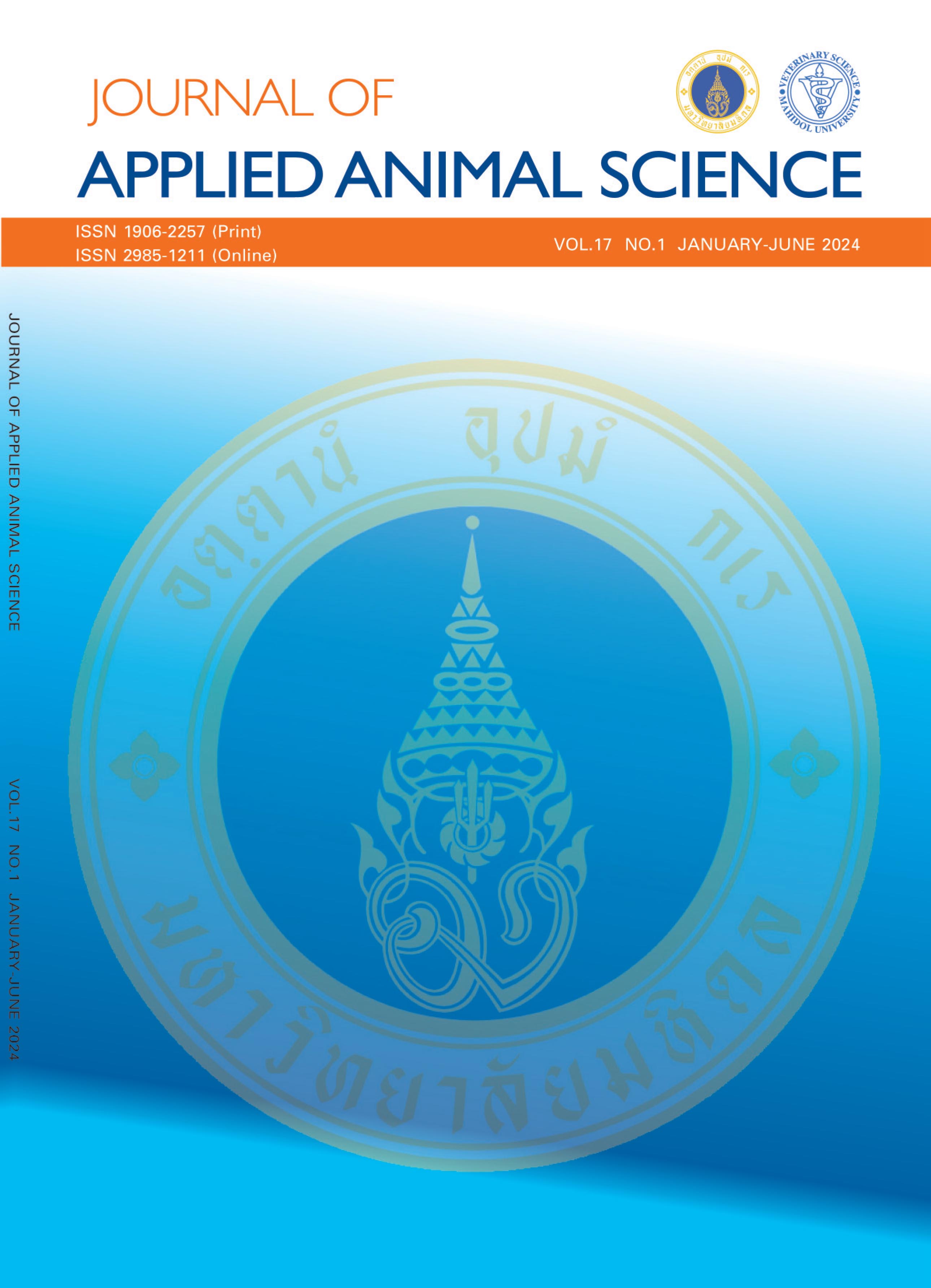A Feline Intestinal Adenocarcinoma in Domestic Shorthair Cat: A Case Report
Keywords:
Feline intestinal adenocarcinoma, Intestinal tumor, Abdominal massAbstract
A 15-year-old, spayed female domestic shorthair cat was presented with clinical signs of weight loss, decreased appetite, and chronic vomiting persisting for more than 3 months. The cat had been given fenbendazole, probiotics, and a hydrolyzed diet; however, the symptoms, including vomiting and diarrhea, waxed and waned. The biochemical results revealed that feline pancreatic lipase, serum folate, and serum cobalamin were still within normal limits. Diagnostic imaging, including abdominal radiograph and ultrasonography, revealed a mass-like lesion cranially located in the urinary bladder and a significant thickening of the small intestinal wall. Due to the marked thickening and apparent obstruction of the jejunal wall, a jejunal resection and anastomosis were performed. The resected jejunal tissue was submitted for fungal culture and histopathologic examination. The microscopic diagnosis of the resected tissue was intestinal adenocarcinoma. Fungal culture on Sabouraud dextrose agar (SDA+) was identified as Aspergillus sp. with a suspect of A. fumigatus. However, no fungal elements were detected by histopathology, and there was no positivity on Periodic Acid Schiff staining. Thus, a fungal infection is indefinite. Abdominal ultrasound conducted three days post-operation revealed a normal wall’s thickness, normal peristalsis, and no dilation of the small intestine. There was no evidence of ascites or peritonitis. No signs of recurrence were detected during the 78 days post-operation. Nevertheless, the disease relapsed with neoplastic abdominal effusion, and a cat died four months after the operation.
References
Arastehfar A, Carvalho A, Houbraken J, Lombardi L, Garcia-Rubio R, Jenks JD, et al. Aspergillus fumigatus and aspergillosis: From basics to clinics. Stud Mycol. 2021;100:100115.
Bakaeen FG, Murr MM, Sarr MG, Thompson GB, Farnell MB, Nagorney DM, et al. What prognostic factors are important in duodenal adenocarcinoma? Arch Surg. 2000;135(6):635-42.
Barry KA, Wojcicki BJ, Middelbos IS, Vester BM, Swanson KS, Fahey GC Jr. Dietary cellulose, fructooligosaccharides, and pectin modify fecal protein catabolites and microbial populations in adult cats. J Anim Sci. 2010; 88(9):2978-87.
Cribb AE. Feline gastrointestinal adenocarcinoma: a review and retrospective study. Can Vet J. 1988;29(9):709.
Czajkowski PS, Parry NM, Wood CA, Casale SA, Phipps WE, Mahoney JA, et al. Outcome and prognostic factors in cats undergoing resection of intestinal adenocarcinomas: 58 Cases (2008-2020). Front Vet Sci. 2022;9:911666.
Green ML, Smith JD, Kass PH. Surgical versus non-surgical treatment of feline small intestinal adenocarcinoma and the influence of metastasis on long-term survival in 18 cats (2000–2007). Can Vet J. 2011;52(10):1101.
Handl S, Dowd SE, Garcia-Mazcorro JF, Steiner JM, Suchodolski JS. Massive parallel 16S rRNA gene pyrosequencing reveals highly diverse fecal bacterial and fungal communities in healthy dogs and cats. FEMS Microbiol Ecol. 2011;76(2):301-10.
Heilmann RM, Riggers DS, Trewin I, Köller G, Kathrani A. Treatment success in cats with chronic enteropathy is associated with a decrease in fecal calprotectin concentrations. Front Vet Sci. 2024;11:1390681.
Kosovsky J, Matthiesen D, Patnaik A. Small intestinal adenocarcinoma in cats: 32 cases (1978-1985). J Am Vet Med Assoc. 1988;192(2):233-5.
John SM, Christiane VL, Matti K. Tumors of the alimentary tract. In: Meuten DJ, editor. Tumors in Domestic Animals. 5th ed. Ames, IA: John Wiley; 2017. p. 499–601
Minamoto Y, Hooda S, Swanson KS, Suchodolski JS. Feline gastrointestinal microbiota. Anim Health Res Rev. 2012;13(1):64-77.
Patnaik A, Liu S-K, Hurvitz A, McClelland A. Nonhematopoietic neoplasms in cats. J Natl Cancer Inst. 1975;54(4):855-60.
Patnaik A, Liu S-K, Johnson G. Feline intestinal adenocarcinoma: a clinicopathologic study of 22 cases. Vet Pathol. 1976;13(1):1-10.
Rissetto K, Villamil JA, Selting KA, Tyler J, Henry CJ. Recent trends in feline intestinal neoplasia: an epidemiologic study of 1,129 cases in the veterinary medical database from 1964 to 2004. J Am Anim Hosp Assoc. 2011;47(1):28-36.
Rivers BJ, Walter PA, Feeney DA, Johnston GR. Ultrasonographic features of intestinal adenocarcinoma in five cats. Vet Radiol Ultrasound. 1997;38:300-6.
Tun HM, Brar MS, Khin N, Jun L, Hui RK-H, Dowd SE, et al. Gene-centric metagenomics analysis of feline intestinal microbiome using 454 junior pyrosequencing. J Microbiol Methods. 2012;88(3):369-76.
Turk M, Gallina A, Russell T. Nonhematopoietic gastrointestinal neoplasia in cats: a retrospective study of 44 cases. Vet Pathol. 1981;18(5):614-20.
Vail DM. BSAVA manual of canine and feline oncology. Quedgeley: British Small Animal Veterinary Association; 2011.
Watanabe T, Hoshi K, Zhang C, Ishida Y, Sakata I. Hyperammonaemia due to cobalamin malabsorption in a cat with exocrine pancreatic insufficiency. J Feline Med Surg. 2012;14(12):942-5.
Willard MD. Alimentary Neoplasia in Geriatric Dogs and Cats. Vet Clin. North Am Small Anim Pract. 2012;42(4):693-706.
Zoran DL. Pancreatitis in cats: diagnosis and management of a challenging disease. J Am Anim Hosp Assoc. 2006;42(1):1-9.
Downloads
Published
How to Cite
Issue
Section
License
Copyright (c) 2024 Mahidol University Faculty of Veterinary Science

This work is licensed under a Creative Commons Attribution-NonCommercial-NoDerivatives 4.0 International License.
Published articles are under the copyright of the Journal of Applied Animal Science (JAAS) effective when the article is accepted for publication. The editorial boards claim no responsibility for the content or opinions expressed by the authors of individual articles in this journal. Partially or totally publication of an article elsewhere is possible only after the consent from the editors.



